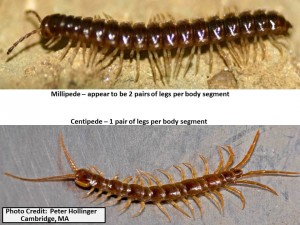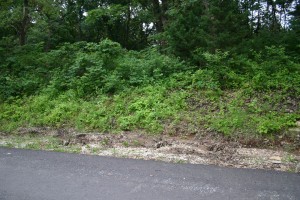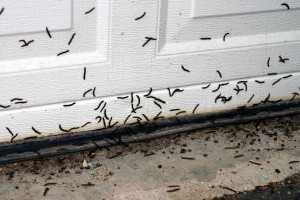–by Dr. Bob Bauernfeind
While I am not saying that this will happen, the excessive spring rains might be conducive to promoting movements of massive populations of millipedes. Millipedes in of themselves are harmless (do not bite, sting transmit diseases), and in fact are beneficial in their natural role as decomposers (feeding on dead organic matter). It is the sudden presence of large populations moving in and about residential properties that can be disconcerting.
Millipedes are elongated wormlike arthropods. They can be differentiated from centipedes by virtue of the number of legs per body segment. Whereas centipedes have a single pair of body legs per segment, millipedes appear to have 2 pairs per body segment. I use “appear” because what appears to be a single body segment actually is comprised of two fused segments, each with a pair of legs.
The two most common body forms for millipedes common are cylindrical and plated (flat-backed). Cylindrical millipedes are sometimes referred to as “wireworms” (not to be confused with “true wireworms” – the larvae of click beetles), and when viewed from above, their legs are somewhat hidden due to their ventral position. The legs of flat-backed millipedes are more highly visible as they project outward from beneath the extended plate.
The life cycle of millipedes extends over a period of years. Depending of conditions, development from egg to adult may require 2 – 4 years, with adults living additional years. Thus over time, millipede populations build up (especially) in heavily wooded areas which satisfy their preference for shaded and moist environments where they primarily feed on decaying organic matter, notably leaf litter.
For reasons unknown, countless numbers of millipedes move/march in droves. They make their presence known when they invade yards and homes. This accounts for reports the reports of “worm invasions”. And although millipedes are harmless to people and pets, they may enter garden areas and sometimes feed on tender plants.
The most common complaint, however, is their disconcerting presence. They are mostly observed around daybreak when massing on sides of buildings, patios/decks, driveways and sidewalks and decorative rocks. Especially on hot sunny days, they rapidly disappear as they seek protective shelter/cover, only to re-emerge during the ensuing evening.
Frustrations arise when attempting to control millipedes. Again, millipedes seek “hiding places” —- any available crack or crevice in the soil, under bark mulch, under landscape stonework, gravel, plastic ground cover, leaf litter in and around homes. Elimination of these protected sites is impractical-to-impossible. Insecticides registered for use as perimeter treatments will eliminate those millipedes in the target area. However repeated applications will be required for the duration of millipede invasions. Another nuisance factor: the dead millipedes will have to be swept up and disposed of. The best news is that millipede activities stop as suddenly as they began!




